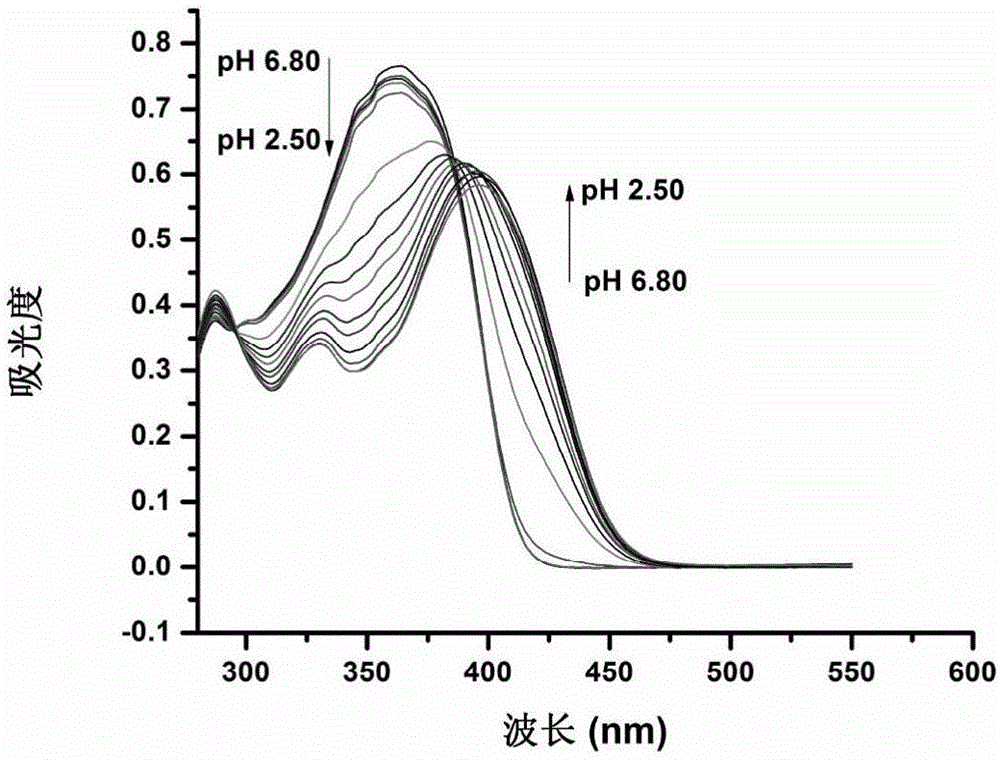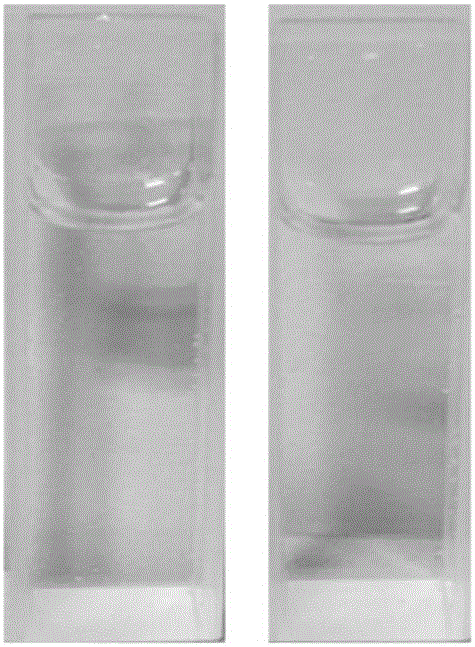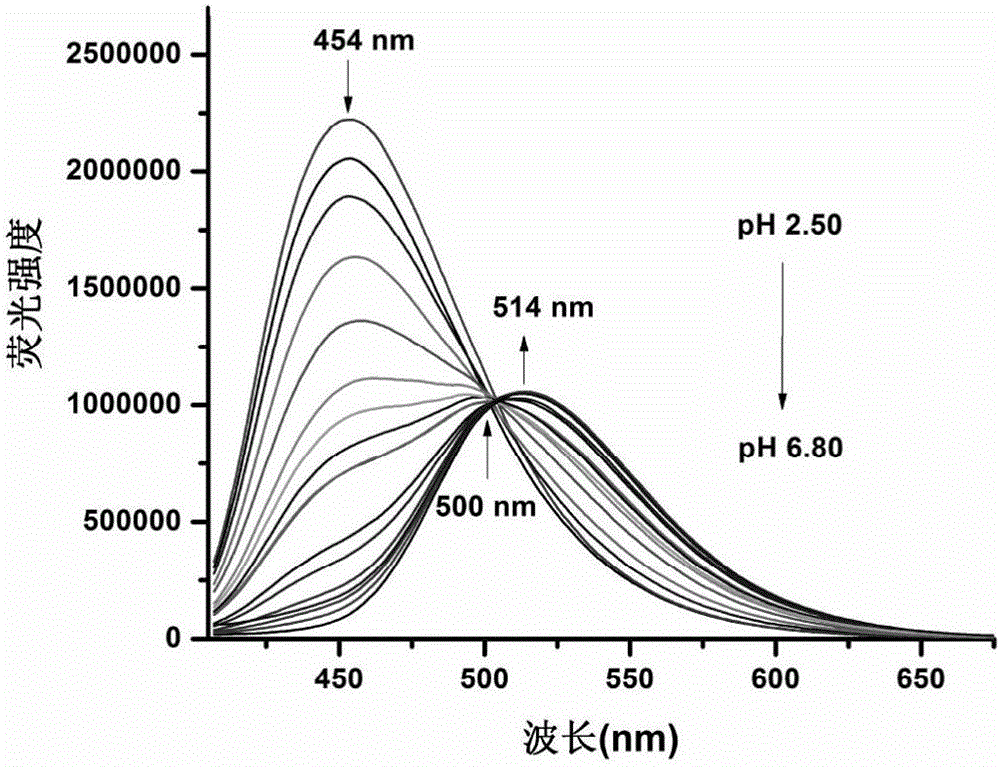Two-photon lysosome pH fluorescence probe, preparation method thereof and application
A fluorescent probe, two-photon technology, applied in fluorescence/phosphorescence, chemical instruments and methods, luminescent materials, etc., can solve problems such as inability to apply real-time high-resolution detection of living tissue, photodamage and photobleaching, and cell photodamage, etc. Achieving the effect of good cell membrane permeability, environmental protection and low cost
- Summary
- Abstract
- Description
- Claims
- Application Information
AI Technical Summary
Problems solved by technology
Method used
Image
Examples
Embodiment 1
[0027] The synthetic steps of probe of the present invention are as follows:
[0028]
[0029] (1) In a sealed tube, add 0.446g of 2-methylbenzimidazole, 0.237g of 9-(2-(2-methoxyethoxy)ethyl)-9H-carbazole-3-carbaldehyde and trimethyl Dissolve 2.28 ml of mole chlorosilane in N,N-dimethylformamide, and heat at 100°C for 24 hours.
[0030] (2) Add saturated Na to the reaction solution 2 CO 3 After adjusting the pH value of the solution to weak alkaline, stir for 1 hour, and use CH 2 Cl 2 Extracted 3 times, combined organic phase, anhydrous Na 2 SO 4 After drying, the crude product was obtained by distillation under reduced pressure.
[0031] (3) The crude product was separated by a silica gel column to obtain the pure product. 1 H-NMR (DMSO-d 6 ,400MHz)δ12.59(m,1H),8.47(d,J=1.2Hz,1H),8.24(d,J=7.6Hz,1H),7.83(d,J=16.4Hz,1H),7.77- 7.79(dd, J=1.2Hz, 1H), 7.64-7.69(dd, J=8.2Hz, 2H), 7.59(d, J=7.2Hz, 1H), 7.45-7.49(m, 2H), 7.22-7.26 (m,2H),7.13-7.20(m,2H),4.59(t,J=5.4Hz,2...
Embodiment 2
[0033] The probe in Example 1 was used to prepare a stock solution with a concentration of 1 mM in DMSO. In the experiment, the probe was diluted with water / DMSO (V / V=4 / 1) system to make the final concentration 30 μM. Regulate the pH value of this system with the HCl of 1mol / L, record the ultraviolet absorption spectrogram under different pH conditions ( figure 1 ). As the pH value decreased from 6.8 to 2.5, the absorption peak at 359nm decreased gradually, and the absorption peak at 396nm increased in turn, and there was an obvious isoelectric point at 380nm. figure 2 It shows that the color of the solution changes from colorless to yellow. The picture on the left is a colorless solution without adding a sample, and the picture on the right is a yellow solution with HCl added to a sample.
Embodiment 3
[0035] Similarly, the probe was diluted to 10 μM with water / DMSO (V / V=4 / 1) system for fluorescence spectrum titration, the excitation wavelength was fixed at 360 nm, and the fluorescence emission spectra under different pH conditions were recorded. like image 3 As shown, under the neutral condition of pH 6.8, the maximum fluorescence emission of the probe is located at 454nm. As the pH decreases, the fluorescence emission at 454nm decreases gradually, and a new fluorescence emission appears at 514nm and is significantly enhanced. exhibits remarkable ratiometric fluorescence emission properties (F 454nm / F 514nm ). At the same time, a clear isoelectric point appears at 500nm. Under the irradiation of ultraviolet light, the color of the solution changes from the blue of the left sample to the green of the right sample ( Figure 4 ). According to the fluorescence intensity ratio (F 454nm / F 514nm ) and the fitting curve of different pH values to calculate pK a The valu...
PUM
 Login to View More
Login to View More Abstract
Description
Claims
Application Information
 Login to View More
Login to View More - R&D
- Intellectual Property
- Life Sciences
- Materials
- Tech Scout
- Unparalleled Data Quality
- Higher Quality Content
- 60% Fewer Hallucinations
Browse by: Latest US Patents, China's latest patents, Technical Efficacy Thesaurus, Application Domain, Technology Topic, Popular Technical Reports.
© 2025 PatSnap. All rights reserved.Legal|Privacy policy|Modern Slavery Act Transparency Statement|Sitemap|About US| Contact US: help@patsnap.com



